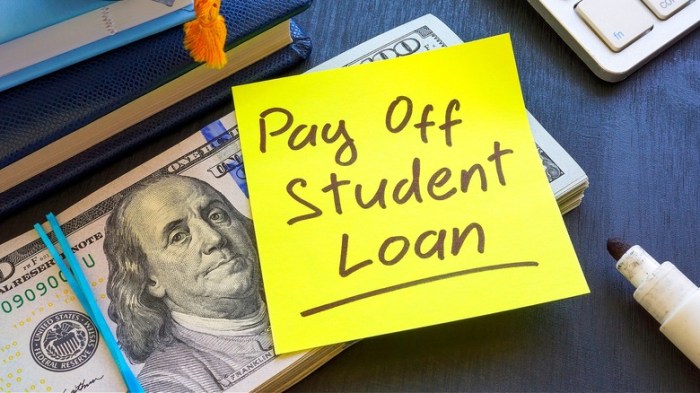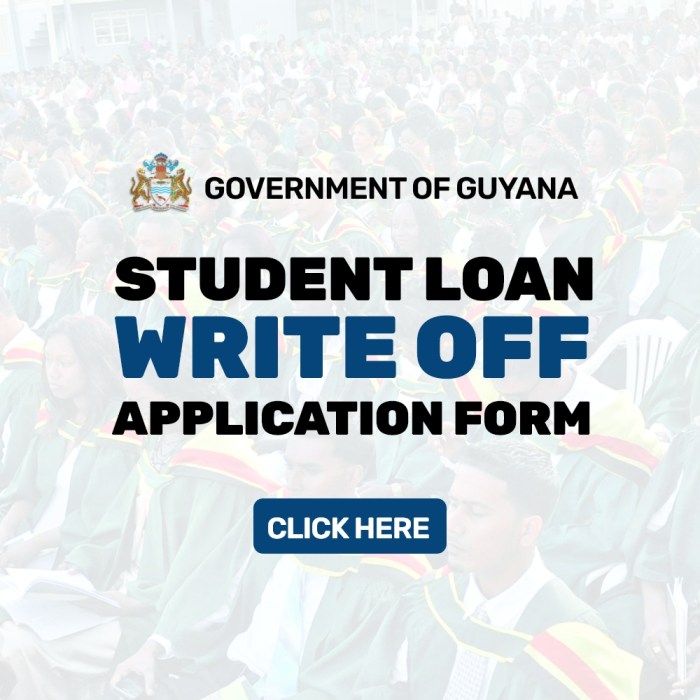
The crushing weight of student loan debt is a reality for millions, often delaying major life milestones like homeownership and starting a family. However, a glimmer of hope exists in the form of student loan forgiveness programs. These programs, while complex, offer the potential for a fresh financial start, but navigating the eligibility requirements and application processes can feel overwhelming. This guide aims to demystify the process, providing a clear understanding of the various pathways to student loan write-offs.
Understanding the nuances of different forgiveness programs, their eligibility criteria, and the potential long-term financial implications is crucial for borrowers seeking relief. We will explore both the individual and broader economic impacts of student loan forgiveness, examining the advantages and disadvantages for borrowers, the higher education sector, and the national economy. This exploration will equip you with the knowledge to determine if these programs are a viable option for your unique circumstances.
Eligibility Criteria for Student Loan Forgiveness
Navigating the complex landscape of student loan forgiveness requires a clear understanding of the various programs available and their specific eligibility requirements. These programs offer potential relief to borrowers facing significant financial burdens, but qualifying often depends on factors like income, loan type, and employment history. This section details the criteria for several key programs.
Public Service Loan Forgiveness (PSLF) Program
The Public Service Loan Forgiveness (PSLF) program offers forgiveness of remaining federal student loan debt after 120 qualifying monthly payments under an income-driven repayment plan while working full-time for a qualifying government or non-profit organization. Eligibility hinges on several key factors. Borrowers must have Direct Loans (not Federal Family Education Loans or FFELs) and be employed by a qualifying employer. The definition of “qualifying employer” is quite broad and includes government organizations at all levels (federal, state, local) and certain non-profit organizations. The employment must be full-time, and payments must be made on time. The application process involves submitting an Employment Certification Form annually to verify employment. Documentation needed includes proof of employment and loan details.
Teacher Loan Forgiveness Program
This program provides forgiveness of up to $17,500 in federal student loan debt for teachers who have completed five years of full-time service in a low-income school or educational service agency. To qualify, teachers must teach in a qualifying school, which is typically determined by the location’s designation as a low-income area. The program requires full-time teaching for five consecutive academic years. Application requires documentation of teaching experience and loan information.
Income-Driven Repayment (IDR) Plans and Forgiveness
Several income-driven repayment (IDR) plans, such as IBR, PAYE, REPAYE, and ICR, can lead to loan forgiveness after a certain number of years, typically 20 or 25, depending on the plan. These plans base monthly payments on income and family size. Forgiveness under IDR plans is generally granted after the required payment period, even if the loan balance isn’t fully repaid. Eligibility is based on income levels and loan type. The application process involves enrolling in an IDR plan and providing income documentation annually.
Comparison of Eligibility Criteria
| Program | Income Threshold | Debt Limit | Employment Requirements |
|---|---|---|---|
| PSLF | Based on income-driven repayment plan; no specific threshold | Remaining balance after 120 qualifying payments | Full-time employment with qualifying government or non-profit organization |
| Teacher Loan Forgiveness | No specific income threshold | Up to $17,500 | Full-time teaching for 5 consecutive academic years at a low-income school or educational service agency |
| IDR Plans (e.g., REPAYE) | Based on income and family size | Remaining balance after 20-25 years of payments | No specific employment requirements |
Impact of Student Loan Write-Offs on Individuals
Having student loans written off can significantly alter an individual’s financial landscape, bringing both immediate relief and long-term implications. The impact varies depending on the loan amount, the individual’s financial situation, and their future plans. Understanding these effects is crucial for effective financial planning.
Short-Term and Long-Term Financial Implications
The immediate impact of student loan forgiveness is often a substantial reduction in monthly expenses. This freed-up cash flow can be used to address other pressing financial needs, such as paying down high-interest debt, saving for a down payment on a house, or increasing contributions to retirement accounts. In the long term, the absence of student loan payments can lead to increased savings and improved financial stability, potentially allowing for earlier retirement or greater investment opportunities. However, it’s important to note that the long-term benefits are contingent on responsible financial management. Failing to budget effectively could negate the positive impacts of loan forgiveness.
Effects on Credit Scores and Future Borrowing Capacity
While student loan forgiveness doesn’t directly damage a credit score, the manner in which the forgiveness is handled can have an indirect impact. If the forgiven amount is reported as income, it could temporarily increase the borrower’s taxable income. More importantly, the absence of a consistent payment history associated with the student loans might slightly affect credit scores, especially if the individual had a history of on-time payments. However, the overall effect is generally minor, and the positive impact of reduced debt on credit utilization ratios often outweighs any negative effects. Future borrowing capacity, however, is likely to improve significantly due to the lower debt-to-income ratio.
Impact on Personal Financial Planning and Budgeting
Student loan forgiveness fundamentally changes the financial picture for many individuals. Pre-forgiveness budgets that heavily featured loan payments must be adjusted to reflect the new reality. This necessitates careful planning to ensure the extra funds are utilized effectively, rather than being frittered away. Individuals may choose to allocate the freed-up funds towards investments, debt consolidation, emergency savings, or increased spending on discretionary items. The key is to create a realistic and sustainable budget that aligns with revised financial goals.
Hypothetical Case Study: The Impact of Student Loan Forgiveness on Sarah Miller
Sarah Miller, a 30-year-old teacher, had $50,000 in student loan debt with monthly payments of $700. After loan forgiveness, her monthly expenses decreased by $700. Sarah initially used this money to pay off her high-interest credit card debt ($5,000) within a year. Then, she began saving aggressively for a down payment on a house, reaching her goal of $20,000 in two years. This demonstrates how loan forgiveness can accelerate financial goals and improve overall financial well-being, provided it is managed responsibly. Without the forgiveness, Sarah would likely have needed several more years to achieve her homeownership goal.
Broader Economic Effects of Student Loan Forgiveness

Student loan forgiveness, on a large scale, presents a complex economic puzzle with potential benefits and drawbacks across various sectors. Understanding these ripple effects is crucial for policymakers and the public alike, as the implications extend far beyond individual borrowers. This section will explore the potential impacts on the overall economy, higher education, and the federal budget.
Impact on the Overall Economy
Widespread student loan forgiveness could inject significant capital into the economy. Borrowers freed from debt payments might increase their spending on goods and services, stimulating economic growth. This increased consumer spending could lead to job creation and higher business revenues. Conversely, there are potential downsides. A sudden influx of cash into the economy could lead to inflation if supply cannot keep pace with increased demand. Furthermore, the potential for increased demand for certain goods or services may lead to regional economic imbalances. The extent of these effects depends heavily on the size and design of the forgiveness program, as well as the overall economic climate.
Effects on the Higher Education Sector and Student Enrollment
The impact of student loan forgiveness on higher education is multifaceted. Some argue that forgiveness could incentivize higher enrollment, as the perceived financial risk of attending college would be reduced. This could lead to increased demand for higher education services, potentially boosting the higher education sector’s revenue and employment. However, others suggest that forgiveness might not significantly alter enrollment patterns, particularly if tuition costs remain high. Furthermore, institutions may not necessarily see increased revenue if the forgiveness program reduces the overall amount of student loan debt outstanding. The long-term impact on higher education would depend on how universities and colleges respond to changes in student demand and the availability of funding.
Consequences for the Federal Budget and National Debt
Student loan forgiveness would undoubtedly have a substantial impact on the federal budget and national debt. The immediate cost would be the amount of debt forgiven, which could be hundreds of billions or even trillions of dollars, depending on the scope of the program. This would increase the national debt and potentially lead to higher interest payments on government debt in the future. Offsetting this cost, however, could be increased tax revenue resulting from the stimulated economic activity mentioned earlier. The net effect on the federal budget remains a subject of ongoing debate, and accurate prediction requires complex economic modeling incorporating various assumptions about economic growth and government spending. For example, the American Rescue Plan, while not solely focused on student loan forgiveness, demonstrates the scale of fiscal impact that such initiatives can have.
Potential Economic Effects Categorized
The economic effects of widespread student loan forgiveness are complex and can be categorized as follows:
- Positive: Increased consumer spending, stimulated economic growth, potential job creation, reduced financial strain on borrowers, potentially increased higher education enrollment.
- Negative: Increased national debt, potential inflation, potential for economic imbalances, potential for decreased incentive for responsible borrowing in the future, uncertainty about the long-term impact on the higher education sector.
- Uncertain: The net effect on the federal budget, the precise impact on higher education enrollment patterns, the extent to which forgiven debt will be reinvested in the economy, the long-term effects on inflation and economic growth.
Types of Student Loans Subject to Write-Offs

Understanding the nuances of student loan forgiveness is crucial, as the eligibility criteria and available options vary significantly depending on the type of loan and the borrower’s circumstances. This section clarifies the differences between federal and private student loans and details the forgiveness options available for various federal loan types.
Federal vs. Private Student Loans and Forgiveness Programs
Federal student loans, disbursed by the U.S. Department of Education, offer various income-driven repayment plans and forgiveness programs, such as Public Service Loan Forgiveness (PSLF). Private student loans, on the other hand, are offered by banks, credit unions, and other private lenders. These loans generally do not have the same government-backed forgiveness options. While some private lenders may offer their own forgiveness programs, these are far less common and typically have much stricter eligibility requirements. The key difference lies in the backing and regulatory oversight; federal loans provide access to a broader range of forgiveness programs than private loans.
Forgiveness Options for Different Federal Student Loan Types
Several types of federal student loans exist, each with its own eligibility requirements for forgiveness programs. Subsidized federal loans have interest paid by the government while the borrower is in school (under certain conditions), while unsubsidized loans accrue interest regardless of enrollment status. Grad PLUS loans are designed for graduate students and have higher interest rates. The availability of forgiveness programs often depends on the loan type and the specific repayment plan chosen. Income-driven repayment plans, for instance, can lead to loan forgiveness after a specified number of qualifying payments.
Public Service Loan Forgiveness (PSLF) Program Requirements
The Public Service Loan Forgiveness (PSLF) program is designed to forgive the remaining balance on federal student loans after 120 qualifying monthly payments under an income-driven repayment plan. Crucially, borrowers must work full-time for a qualifying government or non-profit organization. The definition of “qualifying employment” is strictly defined and requires careful documentation. Failure to meet all the program’s requirements, such as making timely payments and working for a qualifying employer throughout the entire 120-month period, can result in ineligibility for forgiveness. The PSLF program has undergone significant changes in recent years, and borrowers should carefully review the current guidelines.
Comparison of Forgiveness Criteria for Different Federal Student Loan Types
The following table compares the forgiveness criteria for different types of federal student loans. Note that this is a simplified representation, and specific program rules and requirements should be consulted for accurate and up-to-date information.
| Loan Type | Forgiveness Program Eligibility | Key Requirements | Typical Forgiveness Timeline |
|---|---|---|---|
| Subsidized Federal Stafford Loan | Income-Driven Repayment (IDR), PSLF (with qualifying employment) | Meet income requirements for IDR; 120 qualifying payments for PSLF | 20-25 years (IDR); 10 years (PSLF) |
| Unsubsidized Federal Stafford Loan | Income-Driven Repayment (IDR), PSLF (with qualifying employment) | Meet income requirements for IDR; 120 qualifying payments for PSLF | 20-25 years (IDR); 10 years (PSLF) |
| Grad PLUS Loan | Income-Driven Repayment (IDR) | Meet income requirements for IDR | 20-25 years (IDR) |
| Federal Perkins Loan | Loan cancellation programs for specific professions (e.g., teaching) | Specific employment requirements vary by program. | Varies depending on the cancellation program. |
The Role of Income-Driven Repayment Plans

Income-driven repayment (IDR) plans offer a crucial pathway towards student loan forgiveness for eligible borrowers. These plans tie monthly payments to a borrower’s income and family size, resulting in lower monthly payments than standard repayment plans. Over time, this can lead to loan forgiveness after a specified period, often 20 or 25 years, depending on the plan. The key is understanding how these plans function and which one might be most beneficial to your individual circumstances.
IDR plans are designed to make student loan repayment more manageable for borrowers facing financial hardship. By adjusting payments based on income, they provide relief while still working towards eventual loan forgiveness. This differs significantly from standard repayment plans, where consistent, often higher, payments are made over a shorter timeframe. The lower monthly payments afforded by IDR plans can significantly impact a borrower’s budget, allowing them to allocate more resources to other essential expenses.
Income-Driven Repayment Plan Options and Eligibility
Several IDR plans exist, each with specific eligibility requirements. These include the Revised Pay As You Earn (REPAYE), Pay As You Earn (PAYE), Income-Based Repayment (IBR), and Income-Contingent Repayment (ICR) plans. Eligibility generally requires borrowers to have federal student loans and to be enrolled in a repayment plan. Specific requirements vary by plan, often including income limits and loan types. For example, REPAYE generally requires borrowers to have received their first loan disbursement on or after July 1, 2014, while PAYE has stricter income requirements. The Department of Education website provides detailed information on the eligibility criteria for each plan.
Examples of Loan Forgiveness Through IDR Plans
Consider a borrower with $50,000 in federal student loans. Under a standard repayment plan, their monthly payments might be substantial. However, with an IDR plan, their monthly payment might be significantly lower, based on their income and family size. After 20 or 25 years of consistent payments under the IDR plan (depending on the plan and their specific circumstances), the remaining loan balance might be forgiven. This forgiveness would effectively eliminate a substantial debt burden. Another example could involve a borrower with lower income and a larger family size, leading to even lower monthly payments and a quicker path to potential loan forgiveness. The exact amount forgiven will depend on individual circumstances and the chosen IDR plan.
Visual Representation of Loan Forgiveness Through an IDR Plan
Imagine a graph with time on the x-axis and loan balance on the y-axis. The graph begins with a high point representing the initial loan amount. A line then gradually slopes downwards, representing the loan balance decreasing over time due to monthly payments. However, the slope is gentler than it would be under a standard repayment plan, reflecting the lower monthly payments of the IDR plan. After a specified number of years (20 or 25), the line reaches zero, representing complete loan forgiveness. The area under the curve would visually represent the total amount paid over the life of the loan, which is less than what would be paid under a standard repayment plan. The difference between the total amount borrowed and the total amount paid represents the amount of loan forgiveness.
Concluding Remarks
Securing student loan forgiveness can be a transformative experience, offering significant financial relief and opening up new possibilities. While the process may seem daunting, understanding the available programs and their specific requirements is the first step toward achieving financial freedom. By carefully considering your eligibility, navigating the application process, and understanding the long-term consequences, you can effectively leverage these programs to manage your student loan debt and pave the way for a more secure financial future. Remember to thoroughly research each program and seek professional financial advice when necessary.
FAQ Guide
What happens to my credit score after student loan forgiveness?
The impact on your credit score depends on the program and how the write-off is reported. Generally, it’s best to keep your accounts current and in good standing to maintain a healthy credit score. A write-off may not negatively affect your credit score, but it will affect your credit history.
Are private student loans eligible for forgiveness programs?
Generally, federal student loans are eligible for government forgiveness programs. Private student loans typically do not qualify for these programs. Contact your lender to explore potential options.
Can I still claim student loan interest deductions if my loans are forgiven?
No. You can only claim student loan interest deductions for the tax year you paid the interest. Once the loan is forgiven, the interest is no longer considered a payment and thus not deductible.
What if I don’t meet the eligibility requirements for a specific program?
Explore other available programs or repayment plans. Income-driven repayment plans can lower monthly payments, potentially leading to forgiveness after a set period. Consult a financial advisor for personalized guidance.
